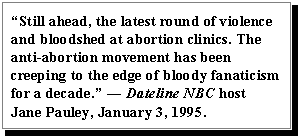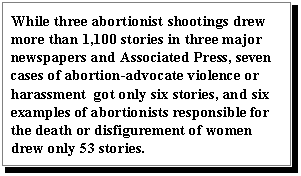Roe Warriors: The Media's Pro-Abortion Bias
Table of Contents:
- Roe Warriors: The Media's Pro-Abortion Bias
- Introduction
- 1. One side is presented as ideological, the other is not.
- 2. The abortion issue is a divisive matter in only one political party.
- 3. Reporters have shown little interest in the facts behind partial-birth abortion.
- 4. Pro-life protests and activities are not news.
- 5. Pro-abortion violence is not news.
- Recommendations for Future Fairness:
5. Pro-abortion violence is not news.
In the last five years, the national media have dramatically promoted the liberal storyline of threats and violence directed at the men and women with the courage to provide abortions to women who want them. Our three-and-a-half year network survey of the boom in abortion-and-violence stories covered the four evening news shows (ABC's World News Tonight, CBS Evening News, NBC Nightly News, and CNN's World News); the three network morning shows (ABC's Good Morning America, CBS This Morning, and NBC's Today); and magazine programs (ABC's Day One, Prime Time Live, and 20/20, CBS's 60 Minutes, 48 Hours, Street Stories, and Eye to Eye with Connie Chung, and NBC's Dateline and Now). Stories were placed in the abortion violence category if they covered a physical altercation (pushing, assault, murder) or threats of violence or injuries resulting from an altercation near a clinic.
"Still ahead, the latest round of violence and bloodshed at abortion clinics. The anti-abortion movement has been creeping to the edge of bloody fanaticism for a decade." - Dateline NBC host Jane Pauley, January 3, 1995.
 In 1992, the networks did only 18 stories on anti-abortion violence.
In 1993, the total exploded to 126, growing further to 228 in 1994 and
129 in the first six months of 1995. The violence angle also grew as a
percentage of the networks' total abortion coverage: in 1993, it became
126 violence stories out of 331 abortion stories (38 percent). In 1994,
it rose to 229 of 374 (61 percent). In the first six months of 1995, it
declined slightly, to 129 stories out of 267 (48 percent). Violence
committed against abortionists or clinic personnel inspired more than
500 network television stories from January 1992 to mid-1995. In the
same four-year span there were only five stories devoted to violence by
abortion advocates or abortionists themselves.
In 1992, the networks did only 18 stories on anti-abortion violence.
In 1993, the total exploded to 126, growing further to 228 in 1994 and
129 in the first six months of 1995. The violence angle also grew as a
percentage of the networks' total abortion coverage: in 1993, it became
126 violence stories out of 331 abortion stories (38 percent). In 1994,
it rose to 229 of 374 (61 percent). In the first six months of 1995, it
declined slightly, to 129 stories out of 267 (48 percent). Violence
committed against abortionists or clinic personnel inspired more than
500 network television stories from January 1992 to mid-1995. In the
same four-year span there were only five stories devoted to violence by
abortion advocates or abortionists themselves.
In print, three anti-abortion shooting incidents drew more than 1,100 stories in seven national print and network outlets in the same time period. By contrast, 13 documented cases of pro-abortion violence attracted only 59 stories in the same outlets. Of those, seven cases of violence or threats from abortion advocates drew only six print media stories. Six examples of abortionists responsible for the death or disfigurement of women from botched abortions drew only 53 print stories.
Using the same sample of three national newspapers and the three national news weeklies used for studying political moderates and extremes, and adding Associated Press dispatches, a Nexis search on the largest stories on abortion and violence demonstrated an unremitting focus on violence against abortion providers. A search for abortionist "David Gunn" drew 549 stories; clinic killer "Paul Hill" pulled up 349 stories; and the last major assailant, "John Salvi," drew 206, for a total of 1,154 news stories through June 30, 1995. (Some of these stories may have included more than one of these names, but the number of mentions does serve to suggest the quantity of reporting).
By contrast, the same sources have little or nothing on incidents of violence or harassment attributed to abortion activists:
Daniel Adam Mahoney was the first pro-abortion activist indicted under the Freedom of Access to Clinic Entrances Act on April 11, 1995. Prosecutors alleged Mathison called the crisis pregnancy center First Way in Wenatchee, Washington on January 2, 1995 and threatened to kill workers at the office. They also alleged he called the National Life Center hotline in Woodbury, New Jersey and told an operator he was going to shoot protesters outside abortion clinics. This was reported on Associated Press on April 11, 1995 and in a New York Times article on April 12, 1995 by reporter David Johnston. AP then followed up with an April 12 dispatch in which abortion advocates supported the Mathison indictment under FACE. AP also reported on June 7, 1995 that Mathison pled guilty. But none of the other outlets in the print sample reported the story, and neither did the networks.
Patricia Baird Windle founded and owned the Aware Clinic for Women in Melbourne, Florida, one of the workplaces of Dr. David Gunn. Windle was mentioned in 30 news stories in our print sample, often testifying to the extremist tactics of the other side. But none of the newspapers or news magazines covered Windle's arrest for improper exhibition of a dangerous weapon on March 30, 1995. In January 1995, three Brevard County public works employees were driving slowly to inspect recent road work in front of Windle's home when Windle waved a gun at them from her driveway. In July 1995, she pled no contest and was sentenced to six months probation and a gun safety course - without any media attention.
Ernest Robertson Jr. was picking up his wife at a Baton Rouge, Louisiana abortion clinic on October 6, 1994. After arguing with a protester, Robertson took out a 9-mm pistol and shot at him once before his gun jammed. He was charged with attempted second-degree murder. The Robertson story did surface in the sample in The New York Times, and briefly on CNN.
Alice Hand was arrested in January 1995 for making at least three phone calls threatening to blow up a Catholic church and school in Suffern, New York. Hand said she believed the Catholic church was partly to blame for anti-abortion violence. The New York Times ran a 288-word story on page B5 on January 17, 1995. But AP, as well as the other newspapers and magazines, ran nothing.
Gainesville (Florida) Right to Life's offices were firebombed with a Molotov cocktail on February 13, 1993, less than a month before the David Gunn murder, reported the Orlando Sentinel. The incident was never mentioned in AP or the other media outlets.
While three abortionist shootings drew more than 1,100 stories in three major newspapers and Associated Press, seven cases of abortion-advocate violence or harassment got only six stories, and six examples of abortionists responsible for the death or disfigurement of women drew only 53 stories.
 The same approach occurred with the violence done to women by
malpracticing abortionists who killed women in their care. Three
editorials, two in The New York Times and one in the Los Angeles Times,
bemoaned botched abortions. But all three focused not on the abortions,
but on the failure of state medical authorities to appropriately remove
and discipline incompetent physicians. None of these stories drew even
a small fraction of the attention given to the anti-abortion shootings:
The same approach occurred with the violence done to women by
malpracticing abortionists who killed women in their care. Three
editorials, two in The New York Times and one in the Los Angeles Times,
bemoaned botched abortions. But all three focused not on the abortions,
but on the failure of state medical authorities to appropriately remove
and discipline incompetent physicians. None of these stories drew even
a small fraction of the attention given to the anti-abortion shootings:
David Benjamin became the first physician in New York state to be convicted of murder because of a botched abortion. Guadalupe Negron bled to death from a perforated uterus in July 1993. Benjamin's license had been revoked for five previous cases of uterine damage in June, but was allowed to practice an additional three weeks until the revocation was final. Paramedics found Negron with a breathing tube inserted into her stomach instead of her lungs. The New York Times published 16 stories, followed by six AP dispatches, four mentions in USA Today, two in the Los Angeles Times, and one in The Washington Post. But none of the networks or news magazines mentioned the story.
Steven Brigham performed abortions in Pensacola, Florida, after the 1993 killing of abortionist David Gunn, but none of the national media outlets in our survey reported that he had lost his license in Pennsylvania, New Jersey, New York, and Georgia. The New York state medical board found Dr. Brigham guilty of "inexcusably bad judgment" and life-threatening negligence that caused serious injury to two patients. The only national distribution of this story came in a December 20, 1994 Gannett News Service story, just before Brigham's license was revoked in Florida.
Allen Kline arrived in Pensacola after the shooting of abortionist John Britton and was mentioned in The New York Times, the Los Angeles Times, and AP. But no media outlet recalled Kline's role in the 1985 death of 13-year-old Dawn Ravenell, which later led to a $1.2 million civil verdict against the clinic where Kline took part in the failed abortion.
Angela Ruiz Hanna had no professional medical training, but performed abortions anyway. In January of 1993, Angela Nieto Sanchez died in her clinic after arriving with two of her children. The Sanchez family later found Hanna trying to load the body of Mrs. Sanchez into her car. The Los Angeles Times filed 11 stories on the case, and AP filed three. But the rest of the media never grasped the story's inherent drama.
Thomas Tucker had his license revoked in Alabama and Mississippi after a patient died after removal of a Norplant contraceptive device. The Mississippi state medical board found him guilty of 32 of 34 counts of unprofessional conduct. Tucker's problems were mentioned in just six AP dispatches and one USA Today story. In 1992 and 1993, before his license was re-voked, Tucker was sympathetically portrayed as the last hope for abortion in Mississippi in 11 national print stories, including The Boston Globe, The New York Times, and The Washington Post.
Suresh Gandotra lost his license in California after Magdalena Ortega-Rodriguez bled to death from a perforated uterus in December 1994. Gandotra had been allowed to practice despite an earlier conviction on billing fraud and allegations of a botched abortion in 1991, which required emergency surgery. Gandotra's case drew only two Los Angeles Times stories, including a long front-page story on March 21, 1995.


